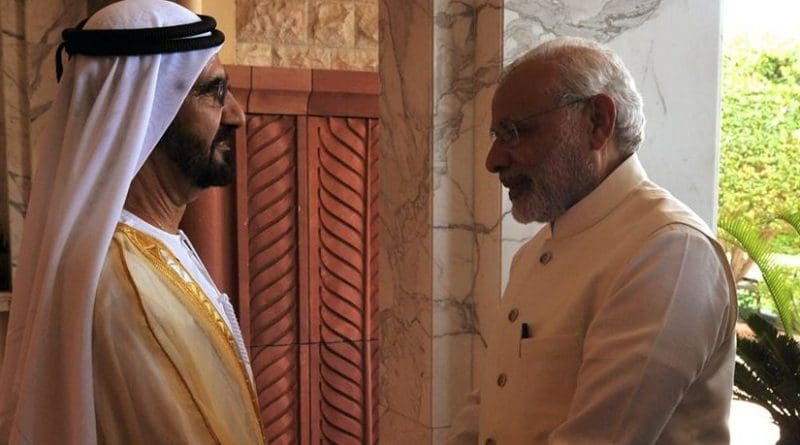Modi’s UAE Visit: Instilling New Energy Into Gulf Ties – Analysis
By Asif Shuja*
The two-day visit of India’s Prime Minister Mr. Narendra Modi to the United Arab Emirates (UAE) on August 16-17, 2015 could be termed as a watershed not only in terms of the bilateral relations of the two countries, but also in terms of India’s engagement with the Gulf and Middle East region. Mr. Modi’s choice of the UAE for starting his Middle East engagement appears to be carefully calculated one. Amidst sectarian conflicts and regional rivalries, the UAE offers a relatively neutral and stable abode for India to make a foothold in the region. Considering the existing deep economic ties and the prospects of further deepening of their relations, absence of a Prime Ministerial visit to the UAE for the last 34 years could give the impression that India was taking for granted such a valued partnership.
Characteristic of him, during his trip to the UAE, Mr. Modi participated in diverse activities. Perusing his dreams of building numerous ‘smart cities’ in India, he took an intensive tour of Masdar city, the high-tech zero-carbon city in Abu Dhabi. He also visited the Sheikh Zayed Grand Mosque in Abu Dhabi and in a goodwill gesture, the Crown Prince of Abu Dhabi decided to allot land for construction of a temple in Abu Dhabi. Still, the most highlighted moment of Mr. Modi’s visit turned out to be his address to 50, 000 Indian expatriates in the Dubai Cricket Stadium.
The visit of Mr. Modi to the UAE was momentous not only for his audience present in the stadium but for the whole of 2.5 million Indian expatriates working in the UAE. This workforce, while remaining integral to the development of the UAE, has been sending back home substantial amount of remittance which has positively contributed to the Indian economy. The visit of Mr. Modi and his announcement of some specific welfare measures, to be carried out through the Indian Embassy in the UAE, had been widely welcomed by the cheering crowd.
During the visit, India’s Prime Minister Mr. Modi and the Crown Prince of Abu Dhabi Mohammed bin Zayed Al Nahyan issued a Joint Statement, elevating the India-UAE relationship to a ‘comprehensive strategic partnership.’ This comprehensive Joint Statement expressed their mutual desire to work jointly in economic, security and defence fields.
India is UAE’s second largest trading partner while UAE is India’s third largest trading partner. Naturally, this visit would serve as a great impetus towards consolidating and further deepening of the relationship between the two countries. Towards that regard, the two countries have expressed their interests to develop the UAE-India Infrastructure Investment Fund, for enabling investment in India’s infrastructural sector, with an aim to reach a target of US$ 75 billion for that fund.
The UAE is rich in sovereign wealth fund; Abu Dhabi itself has a sovereign wealth fund to the tune of US$ 800 billion. As the Indian Prime Minister announced, India offers the potential of foreign investment to the tune of US$ 1 trillion. Further deepening of ties, as enabled by the visit of Mr. Modi, could help India attract a share of that fund for its infrastructure sector. Similarly, the two countries have also expressed their desire to jointly work in the sector of Small and Medium Enterprises for their mutual benefit.
Through the Joint Statement, they expressed their desire to coordinate their efforts in countering the radicalisation and also agreed to cooperate in counter-terrorism operations and intelligence sharing. Towards this end, they also agreed to cooperate on stopping the flow of those funds which promoted radicalisation. This is a new beginning and could not be seen possible just a few years ago when there was no threat to the region by the Islamic State of Iraq and Syria (ISIS).
Coming close on the heels of the recently concluded Iran nuclear deal, the UAE visit of Mr. Modi also has regional implications. India has expressed its desire for deeper engagement with Iran in the post-sanction business environment and some progress such as on the Chabahar port project and the development of Farzad-B gas field are underway. Through Chabahar, Iran hopes to develop a trade hub modelled on Dubai. Under such a scenario, it was only logical to consolidate India’s existing deep ties with the UAE. The UAE could also serve as a good beginning point for Mr. Modi to balance India’s relationship with the Arab world at one hand and Iran on the other.
Despite comprehensive mention of many sectors of cooperation between the two countries as expressed in the Joint Statement, it would remain to be seen how much the UAE delivers in the coming months and years. Nevertheless, mere expression of the desire of mutual cooperation in the critical areas such as counterterrorism, defence and civil nuclear cooperation could be termed as a significant step. With the established of regular summit level meetings, high level ministerial dialogues and regular talks at lower levels, it is hoped that the tangible results would be evident sooner rather than later. One can conclude that the UAE visit of India’s Prime Minister has instilled new energy in India’s engagement with the Gulf region in particular and the Middle East region in general.
*Asif Shuja is a Research Fellow at Indian Council of World Affairs, New Delhi. He can be contacted at: [email protected]

